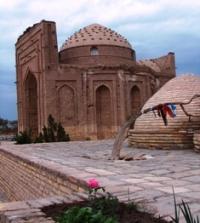You are here
Sultan Ali mausoleum.

Tours from Uzbekistan to Kunya-Urgench.
"The mausoleum Sultan Ali (the XVIth century) is opposite to Nadzhmetdin mausoleum Kubra is scarlet. Two mausoleums form uniform ensemble Kosh. Sultan Ali governed Gurgandzhem in the 16th century. Many scientists believe that on composition, planning and a number of details this mausoleum is the smaller copy of the mausoleum Tyurabeg Hanum"
Tours from Khiva to Turkmenistan.
Mausoleum of Sultan Ali XVI century. or the XVI century (date not specified). Erected in the ensemble "Kosh" with khanaka Nadzhmeddina Kubra. Compositionally, he imitates the mausoleum of the Sufi: in terms of a hexagonal and a rectangular darshanu gurkhan.
Bulk composition is formed by two portal on the main axis, between which two conjugate prism - dvenadtsatigrannaya and octagonal - topped with domes. The interiors - traditional for the XIV century forward-mesh sail.
The mausoleum Sultan Ali (the XVIth century) is opposite to Nadzhmetdin mausoleum Kubra is scarlet. Two mausoleums form uniform ensemble Kosh. Sultan Ali governed Gurgandzhem in the 16th century. Many scientists believe that on composition, planning and a number of details this mausoleum is the smaller copy of the mausoleum Tyurabeg Hanum.
The ensemble of mausoleums of Sultan Ali and Nadzhm-ad-din Kubra is located at the Muslim cemetery which expanded for many centuries around ancient funeral constructions. Both mausoleums stand on one axis and are turned by portals to each other, forming the general court yard.
From lateral faces the court yard is limited by pise-walled and brick hudzhra (cells) and ayvan (terraces) where pilgrims found to themselves a shelter. Sultan Ali mausoleum is of interest mainly in ensemble with the first tomb.
In the mausoleum there are no inscriptions, decorative furniture - both external, and internal. However, the considerable sizes of a construction (a side of an internal hexagon - about 5 meters, diameter of a dome - about 9,5 meters), the undoubted aspiration of architects to reproduce rare composition of the dynastic mausoleum of the period of blossoming of Urgench.
Extremely important location of this mazar in close proximity and composite communication with Kubra Nadzhm-ad-dina who is very esteemed by a tomb and, at last, a traditional binding of construction to a name of Sultan Ali - all this does a construction interesting and attractive to researchers.
From history of Turkmenistan it is known that Sultan Ali lived in the middle of the XIVth century and was "the most of all representatives of a Khan sort which owned, in particular, and Urgench". After Sultan Ali death in 1565 his successor Haji Muhammad khan before living to the northwest in the city of Vazir (nowadays Deukesken-kala ruins), transferred the residence to Urgench.
Possibly, then construction of a tomb of Sultan Ali was also begun. Apparently, the new governor imitated the mausoleum Sufidov with quite definite ideological and political purpose - that to reflect continuity and greatness to Timurids governors of Khorezm in a figurative architectural form.
It is known that after a while internal wars forced to leave Haji Muhammad khan Urgench and to run to Iran, and in the 1580th years to Khorezm the army of the Bukhara khan Abdullah moved. All this also was the reason that Sultan Ali's mausoleum remained unfinished.
Authority:
On materials of information department of the State committee of Turkmenistan on tourism and sport. "Religious and spiritual monuments to Central Asia". Author M. Hashimov. Saga publishing house, 2001.
Photos
Alexander Petrov.







